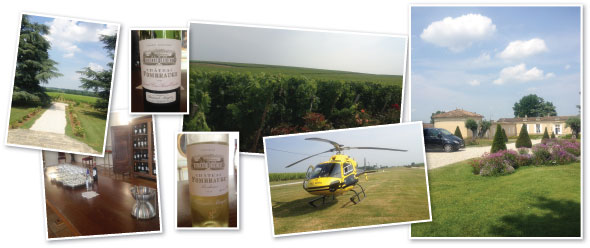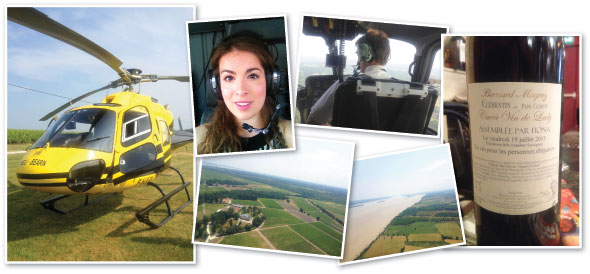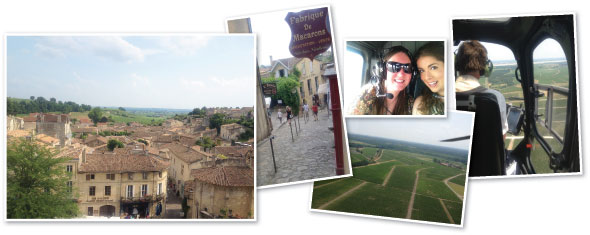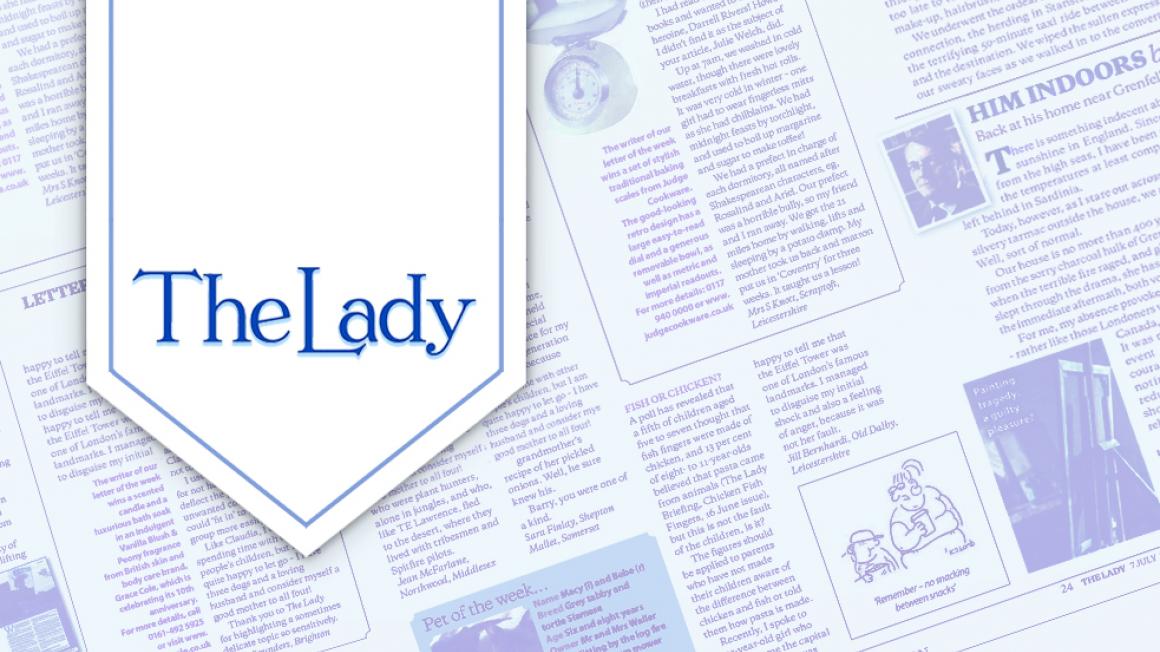A grape adventure
La Château Pape Clément is one of more than 40 estates owned by French wine magnate Bernard Magrez. This château, which was the former home of Pope Clement V, has been in his portfolio since 1988. It is his flagship property and the hub of his business, and he is now inviting fellow wine enthusiasts to stay as part of his Luxury Wine Tourism concept.

Guests can stay in the beautifully appointed rooms of the château at night, and during the day explore the world-renowned Bordeaux wine region. Even those with the most scant knowledge of vino will recognise that Bordeaux and the bottles it produces are the epitome of tradition, refinement and good taste; Magrez’s wine experience aims to follow suit.
Our three day trip commences as we touch down in Bordeaux-Mérignac airport, where we are greeted by a smiling chauffer and a Rolls Royce. This transports us in white-leather comfort to the stately château, where William the butler is waiting to take our bags. The aim is to make you feel that you are the châtelain(e) for the duration of your stay. It’s a heady feeling, and we haven’t even touched a drop of wine yet.

This is soon rectified, however, with the drop of rosé we enjoy with our picnic lunch. ‘Picnic’ is rather a humble word: we sit at a linen-topped table outside in the sunshine, and each receive a wicker basket brimming with delicious breads, cheeses and salad. The food is exceptional, prepared by the château’s esteemed resident chef, Jérôme Bourcié – more on him later.
We find our luggage already placed in our rooms. There are five bedrooms available to guests, each with their own name and character. Mine, ‘La Temperance’, features a tapestry-covered master bed and a crystal chandelier, not to mention a spectacular view. The pink marble bathroom is big, and there is a range of complimentary L’Occitane toiletries to keep you refreshed during your stay.
A trip into the world of Magrez is entirely bespoke, and can be as activity-packed, educational or relaxed as you like. Our group comprised oenophiles ranging from experts to complete novices, but we were all keen to explore the area and enhance our understanding of the winemaking process.

Hence the tour into the cellars. Along with the extraordinary 18 litre Melchiors, amongst the meticulously arranged walls of wine are bottles dating from 1893. They can’t be drunk, of course, but are kept for posterity. Château Pape Clément is steeped in history, which is relayed in charmingly accented English by Arnaud. The tour is a slick operation: as we gaze at the tomb of Pope Clement V (nestled amongst the wine) there is plainsong playing softly in the background which, we later learn, is set up to start the moment the lights are switched on.
The tour moves up into the modern cellars, which is where the real business of winemaking takes place. As a wine-lover who falls more on the novice end of the spectrum, it was fascinating to learn that all the grapes from Pape Clément’s 32 hectares (roughly the size of 25 cricket pitches) are sorted by hand. Every single one. In harvest season, they have 200 people (mostly ladies, ‘because their fingers are smaller!’) working through the day and night, ensuring each and every berry is flawless. Lest you think them old-fashioned, it swiftly becomes clear that all their equipment is state of the art. The above-ground ‘cellar’ houses enormous stainless steel and concrete vats where the 30 hectares worth of red, and two of white, are formed every year.

After a quick peek at the rows of barrels, the final stage where the all-important ageing takes place, it is time for the crux of the tour – the tasting. We sample three of the estates vintages: the white is full-bodied and rich, with notes of toasted brioche (like all the best tastings, you are encouraged to exult in your own tastebuds – no flavour or aroma is dismissed), the 2009 Graves is eminently quaffable and cherry-ish, but the real star of the show is the 2007 Pessac-Léognan , which has smokey, leathery notes with a brilliantly long palate. It is how I imagine the quintessential Bordeaux wine. One very large ‘taster’ down (none of which I opted to eject into the elegant spitting bowl), we learn that the wine retails for around €130. And so the luxury continues.
Over the long weekend, we visit two of Monsieur Magrez’s properties. They are all classified as Grand Crus Reservés (the highest level of classification of AOC wines from Burgundy) but they all have their own personality. Château La Tour Carnet dates from 1120 and is decorated in keeping with its heritage: there is a room sporting a four poster bed, and even an indoor chapel.

Château Frombrauge exhibits more of an archaeological angle, housing a fossil skeleton which was unearthed in the grounds. Even without the wine, it is fascinating to snoop around these properties – it is the French equivalent of country house hopping. We are also schooled in the idiosyncrasies and differences of the winemaking at each of the châteaux by our well-informed and enthusiastic guides, and each ends with that crucial tasting.
A visit to the Institut Culturel (this time in a Bentley) reveals that Magrez’s empire extends beyond winemaking. This is another stately building which is put to use, this time as an art gallery. At the time of our visit the exhibition was a diverse collection of film, photography and paintings (including a piece by Alberto Giacometti) centred around the theme of Venice. Exhibitions run for around four months before they change and it’s definitely worth a visit – there is enough on show to captivate, but not so much that you start to lose interest.
We also visited the historic town of Saint-Émilion during our trip which is an especially bucolic spot, not dissimilar to England’s own Cotswolds. Cobbled streets are lined with cafes and friendly faces giving out samples of sugary macarons – the area’s speciality. Visits of the underground church, which is one of the largest in Europe, can easily be organised at the tourist office too.

In order to hop between the châteaux and quaint towns, only one form of transport is deemed suitable my Mr Magrez: helicopter. Hectare upon hectare of vineyard, interspersed by some of the most beautiful and expensive properties in the country, roll by beneath you as distances dissolve and time stops in the air. It is an extravagant form of travel, but thoroughly in keeping with the tone of Mr Margrez’s tourism.
Back at the château, the downtime before dinner can be filled with a variety of gastronomic themed activities. On the first night we had the pleasure of a cookery class with the aforementioned Jérôme Bourcié. A quintessential French man, he claims to speak no English but is nonetheless adept at getting his culinary points across. From his meticulously organised fridge come an array of high quality ingredients, all of which are used in the preparation of the multi-course meals on offer at the château. During a jovial hour or so, we learn how to skin a pepper, strain a chorizo sauce and make a lamb ‘noisette’. Make no mistake: this is not the sort of cookery class which will have you recreating a slap-up meal at home, rather it is the kind of lesson which gives an insight into the tips and tricks of haute-cuisine. It is incredibly gratifying to see said pepper, sauce and lamb make an appearance in that evening’s meal, not least because it has all been perfected by Jérôme ‘s expertise.

Just as wine is part of the culinary culture, so is la nourriture. Each dinner is silver service and (although not formally awarded thus) of Michelin-star standard. Memorable dishes include the most tender piece of veal I have ever encountered, a divine lavender infused dessert, and a seemingly never-ending supply of fresh baked bread. Wine pairings are a given, and you are kept topped up by a discreet and knowledgeable waitress throughout. Breakfast is a similarly extravagant spread: expect warm croissants, freshly squeezed juices and utterly decadent, utterly delicious truffle-infused scrambled eggs. If that weren’t enough, you are also left a little treat when your bed is turned down for the evening. Homemade cannelles sat elegantly next to the pillow one night, and chocolate raisins the next. Should you wish to dine out, the team on hand at the château can reserve a table for you at the top restaurants in Bordeaux.
The only downside to this insight into the world of winemaking luxury is the thought you have to leave, but happily there is a way to take a token of it with you. Opt for a ‘Become a winemaker’ course and the charming Pierre will guide you through experimenting with ratios of Merlot and Cabernet Sauvignon. There is a lot of tasting, and not a long of spitting which, coupled with the oversized pipettes you’re required to use, swiftly lead to hilarity. When you’ve created the perfect blend for your palette, you fill a bottle and create your own label. My ‘Vin de Lady’ was a quaffable blend of 70% Merlot and 30% Cabernet Sauvignon, and will be prime for drinking in two years.
Three days, a few air miles and countless tasters of wine later, it’s back to the airport. We all agree that Monsieur Magrez is onto something. Like any good vintage, his Luxury Wine Tourism is opulent, sophisticated, and will have you yearning for another taste.

For more information visit www.luxurywinetourism.fr/en


